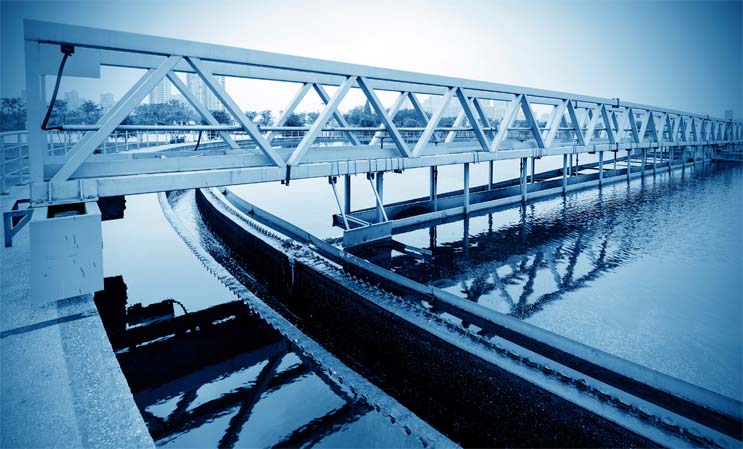The Vital Role Of Measurement In Effective Wastewater Recovery
By Amina Hamidi

How digitalization technologies, including data analytics and asset management, can offer smart, sustainable solutions to our planet’s wastewater treatment challenges — and help combat the problems of global water scarcity.
Our growing thirst for water — for drinking, sanitation, agriculture, and industry — seems unquenchable. Global water demand is expected to increase by 20%–30% by 2050. But with the UN predicting a global water deficit of 40% by 2030, society is facing a catastrophic and possibly unprecedented water crisis as demand substantially outstrips the Earth’s available freshwater supplies.
The situation is already dire for a quarter of our planet’s 8 billion population. The UN states that around a quarter (2.2 billion people) lack access to safely managed drinking water. Meanwhile, some 4.4 billion people live in areas where sanitation is poor or non-existent. With global population projected to increase by a further 2 billion by 2050, it’s clear we need new ways to improve the way that water is managed, from production of potable water through to the discharge and reusability of wastewater.
At the 30th anniversary of World Water Day in March last year, the UN launched its new Water Action Agenda, with the warning that governments must work four times faster to meet the UN’s sixth Sustainable Development Goal (SDG) by 2030. In particular, UN SDG 6.3 calls for an improvement in water quality by halving the proportion of untreated wastewater globally, increasing recycling, and minimizing the release of hazardous materials.
With 48% of global wastewater left uncollected or untreated, achieving SDG 6.3 requires that this figure must be halved to just under 24%. Put another way, reaching the UN’s target means that the total amount of uncollected and/or untreated wastewater that’s currently lost in the wider environment (171.3 billion m3/yr, or ~45 trillion gals/yr) needs to be reduced by 85.6 billion m3/yr (~22.6 trillion gals/yr).
Treated wastewater that’s returned to the water cycle can be reused for irrigation and a wide range of industrial uses, and even for drinking if it’s been suitably processed. At ABB, we’ve been working with researcher Development Economics to explore how wastewater treatment can play a part in alleviating global water scarcity. Based on an analysis of the same data used by the UN, our own investigations confirm an urgent need to accelerate the treatment of wastewater for reuse and reentry into the water cycle. Our research shows that global wastewater treatment capacity needs to increase annually by 8.56 billion m3, or approximately 2.26 trillion gallons, to meet the UN’s goals. Using a 50-millionliter daily (13.2 MGD) capacity wastewater treatment plant as a benchmark, this means that investment in an additional 469 treatment facilities per year is required, equivalent to 3.4 million Olympic swimming pools each year. And here lies the problem: Currently, some 80% of the world’s wastewater flows straight back into the water cycle without being treated for its safe reuse.
A vital resource is literally going down the drain.
Aside from its close relationship with water scarcity, the management of wastewater also plays a huge role in water pollution. Nearly half of all the wastewater coming out of households — from toilets, sinks, drains, and gutters — currently flows back into nature without its harmful substances removed. Reducing the volume of untreated wastewater will similarly reduce the amount of untreated sewage that’s currently being pumped into rivers and oceans with hugely negative effects on public health, fisheries, animals, and marine biodiversity.
The effective management and treatment of wastewater thus has a dual role to play, both in the battle against global water scarcity and helping to manage the impact of untreated sewage on our fragile ecosystem.
Today, there are various wastewater treatment technologies available, including biological treatment, chemical treatment, and membrane filtration. These can be combined in efficient treatment systems capable of producing high-quality treated wastewater. What’s more, advances in technology, including artificial intelligence (AI), machine learning, and cloud and edge computing, can support the optimization of wastewater treatment systems, helping to monitor the quality of wastewater in real time and adjust the treatment process accordingly.
Wastewater treatment is a complex challenge, with the quality and reliability of the output depending on the orchestration of many often-interrelated processes. Water might superficially appear to be a relatively “clean” product compared with heavy industries such as mining, oil refining, and chemical production; however, it’s a little-known fact that water treatment consumes as much as 3% of the world’s total energy output, while contributing to over 1.5% of global greenhouse gas emissions. Meeting the wastewater treatment targets our report has identified must be achieved in the most energy- and resource-efficient way possible. And that’s where the use of technology to support efficient operations and drive better-informed decision-making is key.
Published in 2022, ABB’s Energy Transition Report has explored how greater integration of automation, digital, and electrical technologies can make wastewater plant operations more efficient and sustainable. The report’s findings suggest that the effective application of automation and digital solutions can help wastewater sites reduce their own carbon emissions by up to 2,000 tons per annum. In the context of around 50,000 treatment sites worldwide, that adds up to potential CO2 savings of 100 million tons annually. What’s more, there’s the very welcome additional dividend of forecasted annual operational savings of up to $1.2 million per plant, or a potential $60 billion OPEX savings globally each year.
There’s clearly a lot to play for. So how can digitalization and automation solutions help wastewater operators realize these savings in practice — and contribute to alleviating global water scarcity plus reducing water pollution and improving sustainability?
Toward Digital Water
In a modern wastewater treatment facility, automation focuses on the use of digital systems to monitor and control plant operations in real time. By automating routine tasks and processes, operators can reduce the risk of errors while improving overall efficiency and reliability.
In a typical plant, there are hundreds or thousands of measuring points where sensors monitor a large number of parameters and detect changes in the environment. These range from measurements of pH, dissolved oxygen, presence of other chemicals, and the composition of biogas released during treatment to physical characteristics such as temperature, pressure, level, and flow rates.
As well as measuring the quality of the water being treated, this instrumentation also plays a critical role in helping operators track other crucial performance indicators, including efficiency, energy consumption, and whether equipment is likely to fail or require maintenance. A seemingly innocuous error in readings from a sensor or the unnoticed failure of a control valve can have severe consequences for the quality or safety of water being produced.
As with all process automation challenges, key to optimizing the efficiency and reliability of wastewater treatment is the interpretation and use of accurate data gathered at every stage of a complex journey.
Managing the potentially enormous number of measurement devices in a typical wastewater treatment plant is a major challenge for operators, especially at large sites. With many plants having an operating lifespan of 40 to 50 years, it’s likely that the installed base of sensors, analyzers, and instrumentation systems represents hardware with a mix of ages and communication standards. Many of these devices will have a wealth of data associated with them. And it’s these data that provide the key to optimizing plant performance, efficiency, and safety while reducing operational costs.
A prerequisite for realizing the full value of these data is that it should be readily shareable. This can be a particular challenge for water operators dealing with a multiplicity of systems and communication protocols, and even more so when their operations may be scattered across multiple remote or inaccessible locations.
Helping operators make sense of this data deluge are asset management systems — such as ABB’s Ability SmartMaster platform — that link operational and engineering data with information management. This creates an environment where data can be collected and shared easily with other users who need access to it, either onsite or organization-wide. In this context, cloud and edge computing play a crucial role in storing, processing, and making available large amounts of data collected from IoT sensors and other systems. By accessing data from anywhere, plant owners can make faster, better-informed decisions that help secure better outcomes. ML and AI also have a critical role to play in modern asset management solutions, helping identify deep patterns and trends in large volumes of data collected from IoT sensors and other plant operations. This analysis yields insights that can be harnessed to optimize the efficiency of day-to-day plant operations.

An effective asset management solution pays immediate dividends in enabling predictive maintenance and helping operators to collect and analyze data from vast numbers of devices of different types, makes, and ages. As well as helping gauge when an intervention is necessary, this allows plant operators to build a clear picture of how the performance of a particular device measures up against other similar devices in the fleet. This can be particularly useful where a device — such as a temperature or pressure sensor — is exhibiting anomalous behavior that’s not consistent with other devices in similar or identical applications.
Combining operational technology (OT) and information technology (IT) via a unified asset management platform also gives engineers easy access to critical data via phones and tablets. As well as providing valuable guidance for maintenance and enabling smarter deployment of engineering resources, this simplified access to data also helps to address the growing issue of global skills shortages as experienced specialist engineers retire and are replaced with more generalist team members who may lack the same in-depth knowledge.
The progressive digitalization of sensing and measurement technologies — coupled with the deep analysis of data using AI/ ML, cloud, and edge computing — also unlocks possibilities for water companies to enhance the efficiency, reliability, and cost-effectiveness of their wastewater treatment operations. Traditionally, plant maintenance has followed a fixed schedule where devices and systems are serviced at specified intervals whether they require maintenance or not. This can impact operators through unnecessary downtime while potentially unneeded maintenance takes place, as well as the cost of needlessly replacing devices that are still functioning adequately.
By combining real-time sensor data with AI and ML, operators can spot changes in devices’ behavior, identify potential issues, and even predict when equipment is likely to fail. By scheduling maintenance activities in advance, operators can dramatically reduce the occurrence of actual failures and minimize a plant’s downtime.
Meeting The Challenges Of Water Scarcity
As with any industrial process, identifying opportunities to optimize wastewater treatment processes starts with accurate measurement. The latest advances in smart measurement, asset management, data analytics, and predictive maintenance allow plant operators to make their own contribution to meeting the UN’s sustainable development goals by ensuring that wastewater is treated to the highest quality before being returned to the environment.
While technology can play a significant role in optimizing wastewater treatment, it’s not the only factor. Proper management practices — including source control, wastewater reduction, and effective treatment and disposal — are also critical in ensuring the overall success of treatment as a solution to alleviate water scarcity and reduce water pollution.
About The Author
 Amina Hamidi is the business line manager of ABB’s Instrumentation business within Measurement & Analytics, overseeing smart instrumentation products, solutions, and services. She joined ABB in 1998 as an R&D engineer, became chief technology officer of ABB’s electrification business in 2017, and joined the Measurement & Analytics leadership team in 2022. A French citizen, Amina holds a PhD in electrical engineering from INPL (Institut National Polytechnique de Lorraine, Nancy, France).
Amina Hamidi is the business line manager of ABB’s Instrumentation business within Measurement & Analytics, overseeing smart instrumentation products, solutions, and services. She joined ABB in 1998 as an R&D engineer, became chief technology officer of ABB’s electrification business in 2017, and joined the Measurement & Analytics leadership team in 2022. A French citizen, Amina holds a PhD in electrical engineering from INPL (Institut National Polytechnique de Lorraine, Nancy, France).
